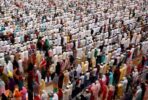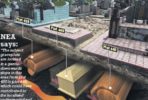It’s good for a country to look back on its history once in awhile. Good to stop and take stock of how far we’ve come, how much more we’ve got to go. It makes sense that we’re doing this on a massive scale during Singapore’s Jubilee year, but there’s one myth that really, really needs to be busted: the narrative of “fishing village to sparkling metropolis”.
A recent BBC article framed Singapore’s growth as “swamp to skyscrapers” – a narrative most Singaporeans are familiar with by now. It’s a story we were told in schools, reinforced by numerous National Day Parades and referred to so regularly that it’s often left unquestioned.
Yet it doesn’t take very long to find the flaws in the story. Colonised by the British in the early 1800s, Singapore was a major hub of entrepôt trade. It was an important wealth-spinner for the colonial masters; they would never have left it primitive and under-developed. Infrastructure needed to be built to support all the administrative and commercial activities that came with establishing a major port, and build it they did.
In fact, the British were only the latest – and most remembered – to have carried out significant activities in Singapore. Textbooks in schools have been revised to go beyond the 1800s, so as to better reflect the richness of Singapore’s history. They now include, for example, Singapore’s role as a trading post in the 1300s – over six centuries before Singapore became a sovereign nation-state.
The importance of dismantling the “swamp to skyscrapers” myth is not just about correcting historical accuracy. It’s also about politics.
This narrative – with all its connotations of “swamps” being rough, poor and undesirable, while “skyscrapers” are modern, wealthy and impressive – suggests that Singapore had nothing when we were first required to stand on our own two feet in 1965. If we accept that premise, it then follows that everything we have today came from the efforts and genius of the political leaders who governed this country.
By the time we get to this point of the story, the politics of gratitude and obedience would have already kicked in. Implicit behind all this is also that fearful, anxious voice, whispering: “How easily all this can be lost, if we make the wrong move, if we vote for the wrong party, if we allow too much dissent!”
There’s no denying that, for better or worse, the PAP has had a huge impact on Singapore’s development. That our political leaders – especially those in the early years of independence – have accomplished a remarkable feat of forward-looking city planning.
But to buy into the “swamp to skyscrapers” or “fishing village to metropolis” narrative is to fail to see the full story. It’s to fail to see that by the time Singapore achieved full independence it already had an established legal system and penal code, with administrative centres and even Southeast Asia’s first air-conditioned skyscraper (as pointed out on Twitter). It’s to fail to see that Singapore is, and has always been, far more than the PAP, far more than the colonial masters, far more than any partisan politics or economic philosophy or political ideology we have ever encountered.
That’s a perspective I find far more honest and exciting than the that of sudden transformation from tropical swampland to glass-and-steel megacity. It’s the idea that Singapore has endured, can endure,will endure far beyond what we can conceive for it – and that leaves us with so much more space to dream, to imagine, and to dare.
Kirsten Han is a Singaporean blogger, journalist and filmmaker. She is also involved in the We Believe in Second Chances campaign for the abolishment of the death penalty. A social media junkie, she tweets at @kixes. The views expressed are her own.
Source: https://sg.news.yahoo.com







